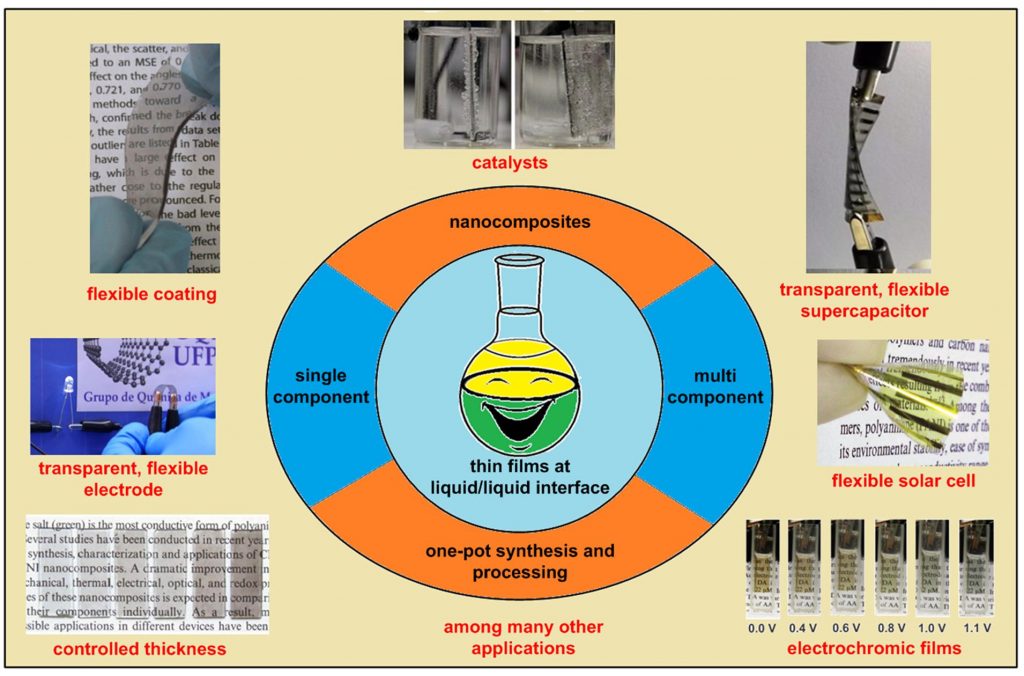
In 2010, Professor Aldo José Gorgatti Zarbin and co-authors published the first article on a simple and inexpensive technique that allows obtaining high-quality thin films at the interface between two immiscible liquids, such as water and oil. The route essentially consists of dispersing the material to be processed in one of the liquids and shaking the system. Afterwards, if the process parameters are properly controlled, nature takes care of organizing the material at the interface of the liquids, generating a solid film that can be easily deposited on other materials.
The discovery looked promising, and over the next decade, the Materials Chemistry Group at the Brazilian Federal University of Paraná (UFPR), led by Zarbin, continued to make efforts to understand and master the process, and to test it with various materials, substrates and applications. The results exceeded the expectations. The “liquid/liquid interfacial route,” as it was termed, allows not only to process practically all materials in the form of films, but also to synthesize them, process them and modify their surface in the same step, within the “magical” environment of the interface between the liquids.
In 2020, ten years after the first article, Aldo Zarbin was invited by Materials Horizons, a scientific journal of the Royal Society of Chemistry with an impact factor of 12.319, to write a review article on this technique that was developed and optimized in Brazil. The review was published earlier this year.
In this interview, the researcher Aldo Zarbin, who is a member of B-MRS, briefly explains the characteristics and possibilities of this route for obtaining thin films – materials that are increasingly in demand in diverse areas such as energy and health. In fact, the thickness and large surface area of thin films make it possible to control the properties of a system without substantially modifying it and without using large amounts of material.
Aldo Zarbin is Full Professor at the Department of Chemistry at UFPR. He has a bachelor’s (1990), master’s (1993) and doctoral degree (1997) in Chemistry from the State University of Campinas (UNICAMP). He is a fellow of the Royal Society of Chemistry and a full member of the Brazilian Academy of Sciences (ABC). He was president of the Brazilian Chemical Society from 2016 to 2018 and serves as vice-coordinator of the Brazilian National Institute of Science and Technology in Carbon Nanomaterials. Professor Aldo Zarbin is the author of over 150 scientific articles. According to Google Scholar, his works have more than 6,800 citations and his h-index is 47.
B-MRS Newsletter: Tell us a little about the history behind the development of the liquid/liquid interfacial route.
Aldo Zarbin: We had been working with interfaces between immiscible liquids since 2001, in the synthesis of silver and gold nanoparticles by the Brust method. At that time, we innovated the preparation of nanocomposites with polyaniline, performing the polymerization directly in the two-phase system. In Rodrigo V. Salvatierra’s master’s thesis (which began in 2008 under my supervision and was co-supervised by Prof. Marcela M. Oliveira, from UTFPR), the proposal was to prepare nanocomposites of carbon nanotubes and polyaniline in a two-phase system, and while developing that research we observed that under certain experimental conditions the product was formed at the interface between the two liquids, in the form of an extremely resistant film. We found that this interfacial film remained intact, so we developed a simple system to remove it and deposit over solid substrates, concluding that it was possible to perform deposition over any type of substrate, while maintaining a high optical quality. Based on this experimental evidence, we started to work in order to understand the phenomenon and explain the formation mechanism, which resulted in our first paper published on the subject, in the Chemistry of Materials of the American Chemical Society in 2010. In this work, we demonstrated the preparation of different transparent films between polyaniline and carbon nanotubes, with different proportions between the components, with strong characterization work and explanation of the formation mechanism. From this first work, we naturally started to study the possibility of extending the technique to other materials, and also for real applications. Rodrigo V. Salvatierra’s doctoral thesis (which was awarded the 2015 Capes Prize for a thesis in Chemistry) showed the first application, as a transparent electrode in an organic solar cell. The paper was published in Advanced Functional Materials (Wiley) in 2013, in collaboration with Professor Lucimara S. Roman’s group, from DFIS-UFPR. In parallel, several other works of master’s thesis and doctoral thesis were being carried out, to optimize the process, to understand the role of the interface, to expand the number of materials, to demonstrate different applications, allowing us reach the present day with a very significant understanding of the entire process, as well as application demonstrations in sensors, solar cells, supercapacitors and flexible and transparent batteries, transparent electrodes, catalysts, electrochromic materials, and other applications.
B-MRS Newsletter: How was the technique received by the scientific community over time?
Aldo Zarbin: The technique was widely accepted in the scientific community because of its several differentials. The main one regards the possibility of combining in a single system the preparation of highly sophisticated materials, as well as their processing as a thin film. Preparing already processed material is a tremendous advantage in the area for applications in different devices and systems. Thus, multicomponent materials that cannot be deposited as a film by the known routes, mainly transparent films, were able to be prepared using this technique. This feature made the works to be accepted and published in high-impact journals, and allowed us to be invited to present seminars at different congresses and institutions in Brazil and abroad, culminating with the publication of this review, by invitation, in Materials Horizons. In addition, several laboratories around the world started to use the technique, citing the works developed here at GQM-UFPR.
B-MRS Newsletter: To what extent was this route and the phenomena associated with it original when you and your collaborators developed the technique?
Aldo Zarbin: In short, the technique takes advantage of the high interfacial tension between two immiscible liquids, to stabilize solids at this interface in order to minimize this tension. This process of stabilizing solids at interfaces between immiscible liquids has been known for a long time, since the Pickering emulsions at the beginning of the 20th century and studied by the scientific community in recent years, which has greatly facilitated our work. Several groups had also been publishing results exploring materials stabilized at these interfaces, such as metal nanoparticles and semiconductors, carbon nanotubes and different polymers. Our differential, as well as our originality, was to demonstrate that it is possible to stabilize this solid in order to connect the units, giving it a homogeneous and stable film characteristic, and not simply a “cluster” in the solid interface. This is controlled by experimental parameters that we have optimized and described; secondly, we were the first to demonstrate that this film could be removed from the liquid/liquid interface to be deposited on different substrates, that is, to use this phenomenon as a thin film deposition technique; and finally, we were pioneers in the synthesis of multicomponent materials directly in the liquid/liquid system, in a one-pot and one-step process, where the multicomponent material is already synthesized and processed in film form.
B-MRS Newsletter: Please use this space to publicize the liquid/liquid interfacial route, with its advantages and limitations, in the Materials Science and Technology community, considering the people who could use it.
Aldo Zarbin: Let’s first look at the advantages of the technique, considering only film deposition, regardless of the material (i.e., if we start with an existing material, or if we use the technique to initially synthesize the material): i) extremely cheap; ii) extremely secure; iii) it does not require temperature, pressure, or sophisticated experimental apparatus; iv) allows deposition on substrates of any format, and any composition, including plastics; v) allows controlling film thickness; vi) produces transparent films; vii) produces films of some materials that cannot be produced by conventional techniques, and is especially indicated for insoluble materials that are difficult to be treated, such as nanocomposites for example.
Any industrial application that requires coating parts or substrates can benefit from the technique, using the correct material for the desired purpose: anti-corrosion applications; protection against chemical attacks; electromagnetic shielding; static dissipation; motion, pressure, crack, gas sensors; smart coatings; electrochromic windows; energy applications such as solar cells, batteries and supercapacitors; as catalysts etc.
Limitations are also highlighted in the review. The main one is that it is still a laboratory method, we have no experience with scaling it for large-scale production, which is a basic requirement for industrial applications. Another problem is that we still do not have experience in coating large areas, on a square meter scale, for example. Both limitations are engineering problems that I believe can be easily overcome, with research and development investment in the technique.

Review article reference: Liquid–liquid interfaces: a unique and advantageous environment to prepare and process thin films of complex materials. Aldo J.G. Zarbin. Mater. Horiz., 2021.8, 1409-1432. Available in open access format at https://doi.org/10.1039/D0MH01676D.
